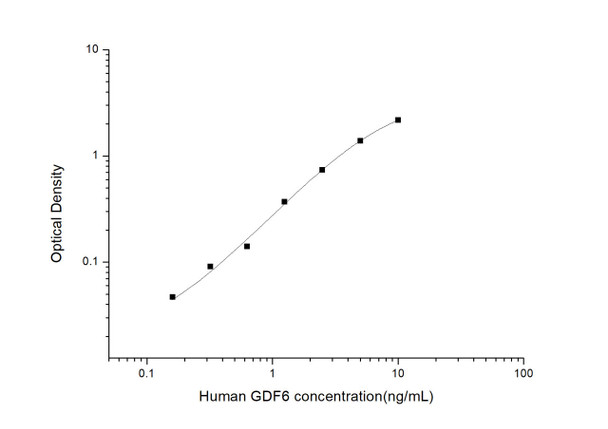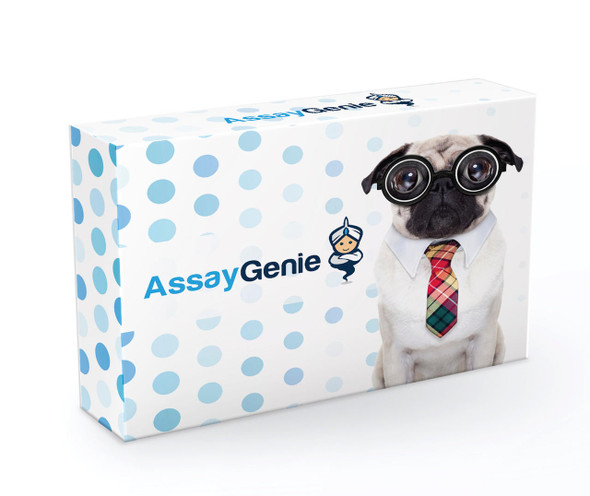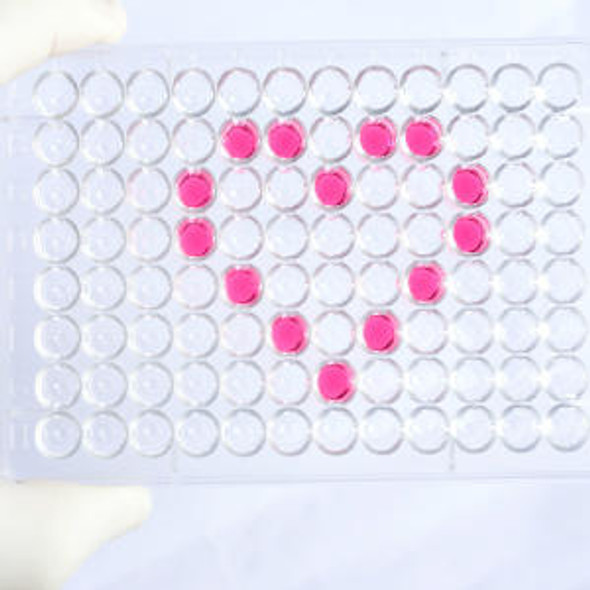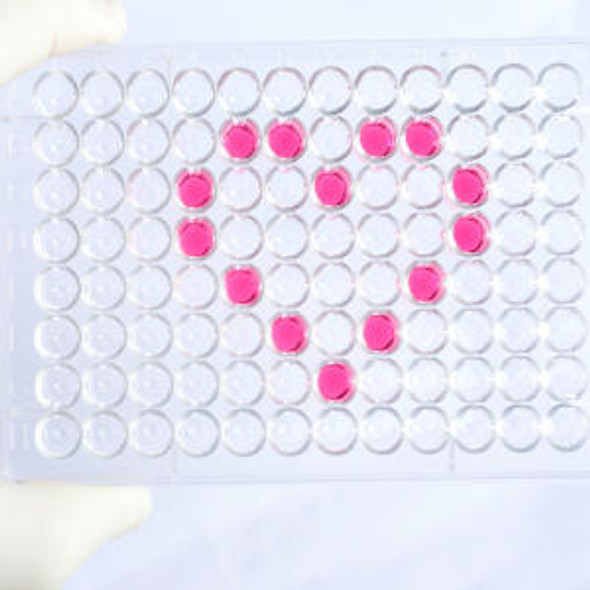Human Cell Death ELISA Kits
Human GDF6 (Growth Differentiation Factor 6) ELISA Kit (HUES02858)
- SKU:
- HUES02858
- Product Type:
- ELISA Kit
- Size:
- 96 Assays
- Uniprot:
- Q6KF10
- Sensitivity:
- 0.09ng/mL
- Range:
- 0.16-10ng/mL
- ELISA Type:
- Sandwich
- Synonyms:
- BMP13, CDMP2, KFS, KFSL, MCOP4, MGC158100, MGC158101, SCDO4, SGM1,MCOPCB6,KFS1,
- Reactivity:
- Human
- Sample Type:
- Serum, plasma and other biological fluids
- Research Area:
- Cell Death
Description
| Assay type: | Sandwich |
| Format: | 96T |
| Assay time: | 4.5h |
| Reactivity: | Human |
| Detection Method: | Colormetric |
| Detection Range: | 0.16-10 ng/mL |
| Sensitivity: | 0.10 ng/mL |
| Sample Volume Required Per Well: | 100µL |
| Sample Type: | Serum, plasma and other biological fluids |
| Specificity: | This kit recognizes Human GDF6 in samples. No significant cross-reactivity or interference between Human GDF6 and analogues was observed. |
This ELISA kit uses Sandwich-ELISA as the method. The micro ELISA plate provided in this kit has been pre-coated with an antibody specific to Human GDF6. Standards or samples are added to the appropriate micro ELISA plate wells and combined with the specific antibody. Then a biotinylated detection antibody specific for Human GDF6 and Avidin-Horseradish Peroxidase (HRP) conjugate are added to each micro plate well successively and incubated. Free components are washed away. The substrate solution is added to each well. Only those wells that contain Human GDF6, biotinylated detection antibody and Avidin-HRP conjugate will appear blue in color. The enzyme-substrate reaction is terminated by adding Stop Solution and the color turns yellow. The optical density (OD) is measured spectrophotometrically at a wavelength of 450 nm ± 2 nm. The OD value is proportional to the concentration of Human GDF6. The concentration of Human GDF6 in samples can be calculated by comparing the OD of the samples to the standard curve.
| UniProt Protein Function: | GDF6: Required for normal formation of bones and joints in the limbs, skull, and axial skeleton. Plays a key role in establishing boundaries between skeletal elements during development. Defects in GDF6 are the cause of Klippel-Feil syndrome type 1 (KFS1). A skeletal disorder characterized by congenital fusion of cervical vertebrae. It is due to a failure in the normal segmentation of vertebrae during the early weeks of fetal development. The clinical triad consists of short neck, low posterior hairline, and limited neck movement. Deafness is a well- known feature of KFS and may be of sensorineural, conductive, or mixed type. A chromosomal aberration involving GDF6 has been found in a patient with Klippel-Feil syndrome (KFS). Paracentric inv(8)(q22;2q23. 3). Defects in GDF6 are the cause of microphthalmia isolated type 4 (MCOP4). A disorder of eye formation, ranging from small size of a single eye to complete bilateral absence of ocular tissues. Ocular abnormalities like opacities of the cornea and lens, scaring of the retina and choroid, cataract and other abnormalities like cataract may also be present. Belongs to the TGF-beta family. |
| UniProt Protein Details: | Protein type:Cytokine; Cell development/differentiation; Secreted, signal peptide; Secreted Chromosomal Location of Human Ortholog: 8q22. 1 Cellular Component: extracellular space Molecular Function:cytokine activity; growth factor activity; protein homodimerization activity; transforming growth factor beta receptor binding Biological Process: activin receptor signaling pathway; apoptosis; BMP signaling pathway; cell development; growth; positive regulation of neuron differentiation; positive regulation of transcription, DNA-dependent; regulation of apoptosis; regulation of MAPKKK cascade Disease: Klippel-feil Syndrome 1, Autosomal Dominant; Leber Congenital Amaurosis 17; Microphthalmia, Isolated 4; Microphthalmia, Isolated, With Coloboma 6 |
| NCBI Summary: | This gene encodes a member of the bone morphogenetic protein (BMP) family and the TGF-beta superfamily of secreted signaling molecules. It is required for normal formation of some bones and joints in the limbs, skull, and axial skeleton. Mutations in this gene result in colobomata, which are congenital abnormalities in ocular development, and in Klippel-Feil syndrome (KFS), which is a congenital disorder of spinal segmentation. [provided by RefSeq, Jul 2008] |
| UniProt Code: | Q6KF10 |
| NCBI GenInfo Identifier: | 74748876 |
| NCBI Gene ID: | 392255 |
| NCBI Accession: | Q6KF10. 1 |
| UniProt Secondary Accession: | Q6KF10,Q6PI58, |
| UniProt Related Accession: | Q6KF10 |
| Molecular Weight: | 50,662 Da |
| NCBI Full Name: | Growth/differentiation factor 6 |
| NCBI Synonym Full Names: | growth differentiation factor 6 |
| NCBI Official Symbol: | GDF6 |
| NCBI Official Synonym Symbols: | KFM; KFS; KFS1; KFSL; SGM1; BMP13; CDMP2; LCA17; MCOP4; SCDO4; BMP-13; MCOPCB6 |
| NCBI Protein Information: | growth/differentiation factor 6 |
| UniProt Protein Name: | Growth/differentiation factor 6 |
| UniProt Synonym Protein Names: | Bone morphogenetic protein 13; BMP-13; Growth/differentiation factor 16 |
| Protein Family: | Growth/differentiation factor |
| UniProt Gene Name: | GDF6 |
| UniProt Entry Name: | GDF6_HUMAN |
As the OD values of the standard curve may vary according to the conditions of the actual assay performance (e. g. operator, pipetting technique, washing technique or temperature effects), the operator should establish a standard curve for each test. Typical standard curve and data is provided below for reference only.
| Concentration (ng/mL) | O.D | Average | Corrected |
| 10 | 2.221 2.261 | 2.241 | 2.17 |
| 5 | 1.439 1.479 | 1.459 | 1.388 |
| 2.5 | 0.824 0.8 | 0.812 | 0.741 |
| 1.25 | 0.433 0.451 | 0.442 | 0.371 |
| 0.63 | 0.211 0.211 | 0.211 | 0.14 |
| 0.32 | 0.17 0.154 | 0.162 | 0.091 |
| 0.16 | 0.117 0.119 | 0.118 | 0.047 |
| 0 | 0.071 0.071 | 0.071 | -- |
Precision
Intra-assay Precision (Precision within an assay): 3 samples with low, mid range and high level HumanGDF6 were tested 20 times on one plate, respectively.
Inter-assay Precision (Precision between assays): 3 samples with low, mid range and high level HumanGDF6 were tested on 3 different plates, 20 replicates in each plate.
| Intra-assay Precision | Inter-assay Precision | |||||
| Sample | 1 | 2 | 3 | 1 | 2 | 3 |
| n | 20 | 20 | 20 | 20 | 20 | 20 |
| Mean (ng/mL) | 0.53 | 1.16 | 3.78 | 0.57 | 1.12 | 3.69 |
| Standard deviation | 0.03 | 0.05 | 0.12 | 0.03 | 0.06 | 0.13 |
| C V (%) | 5.66 | 4.31 | 3.17 | 5.26 | 5.36 | 3.52 |
Recovery
The recovery of HumanGDF6 spiked at three different levels in samples throughout the range of the assay was evaluated in various matrices.
| Sample Type | Range (%) | Average Recovery (%) |
| Serum (n=5) | 89-100 | 94 |
| EDTA plasma (n=5) | 92-105 | 99 |
| Cell culture media (n=5) | 85-100 | 91 |
Linearity
Samples were spiked with high concentrations of HumanGDF6 and diluted with Reference Standard & Sample Diluent to produce samples with values within the range of the assay.
| Serum (n=5) | EDTA plasma (n=5) | Cell culture media (n=5) | ||
| 1:2 | Range (%) | 86-101 | 93-108 | 96-108 |
| Average (%) | 92 | 99 | 101 | |
| 1:4 | Range (%) | 89-103 | 80-90 | 85-97 |
| Average (%) | 95 | 85 | 90 | |
| 1:8 | Range (%) | 87-102 | 81-96 | 83-94 |
| Average (%) | 94 | 87 | 88 | |
| 1:16 | Range (%) | 86-99 | 82-92 | 88-101 |
| Average (%) | 92 | 87 | 95 |
An unopened kit can be stored at 4°C for 1 month. If the kit is not used within 1 month, store the items separately according to the following conditions once the kit is received.
| Item | Specifications | Storage |
| Micro ELISA Plate(Dismountable) | 8 wells ×12 strips | -20°C, 6 months |
| Reference Standard | 2 vials | |
| Concentrated Biotinylated Detection Ab (100×) | 1 vial, 120 µL | |
| Concentrated HRP Conjugate (100×) | 1 vial, 120 µL | -20°C(shading light), 6 months |
| Reference Standard & Sample Diluent | 1 vial, 20 mL | 4°C, 6 months |
| Biotinylated Detection Ab Diluent | 1 vial, 14 mL | |
| HRP Conjugate Diluent | 1 vial, 14 mL | |
| Concentrated Wash Buffer (25×) | 1 vial, 30 mL | |
| Substrate Reagent | 1 vial, 10 mL | 4°C(shading light) |
| Stop Solution | 1 vial, 10 mL | 4°C |
| Plate Sealer | 5 pieces | |
| Product Description | 1 copy | |
| Certificate of Analysis | 1 copy |
- Set standard, test sample and control (zero) wells on the pre-coated plate and record theirpositions. It is recommended to measure each standard and sample in duplicate. Note: addall solutions to the bottom of the plate wells while avoiding contact with the well walls. Ensuresolutions do not foam when adding to the wells.
- Aliquot 100µl of standard solutions into the standard wells.
- Add 100µl of Sample / Standard dilution buffer into the control (zero) well.
- Add 100µl of properly diluted sample (serum, plasma, tissue homogenates and otherbiological fluids) into test sample wells.
- Cover the plate with the sealer provided in the kit and incubate for 90 min at 37°C.
- Aspirate the liquid from each well, do not wash. Immediately add 100µL of BiotinylatedDetection Ab working solution to each well. Cover the plate with a plate seal and gently mix. Incubate for 1 hour at 37°C.
- Aspirate or decant the solution from the plate and add 350µL of wash buffer to each welland incubate for 1-2 minutes at room temperature. Aspirate the solution from each well andclap the plate on absorbent filter paper to dry. Repeat this process 3 times. Note: a microplatewasher can be used in this step and other wash steps.
- Add 100µL of HRP Conjugate working solution to each well. Cover with a plate seal andincubate for 30 min at 37°C.
- Aspirate or decant the solution from each well. Repeat the wash process for five times asconducted in step 7.
- Add 90µL of Substrate Reagent to each well. Cover with a new plate seal and incubate forapproximately 15 min at 37°C. Protect the plate from light. Note: the reaction time can beshortened or extended according to the actual color change, but not by more than 30min.
- Add 50 µL of Stop Solution to each well. Note: Adding the stop solution should be done inthe same order as the substrate solution.
- Determine the optical density (OD value) of each well immediately with a microplate readerset at 450 nm.






